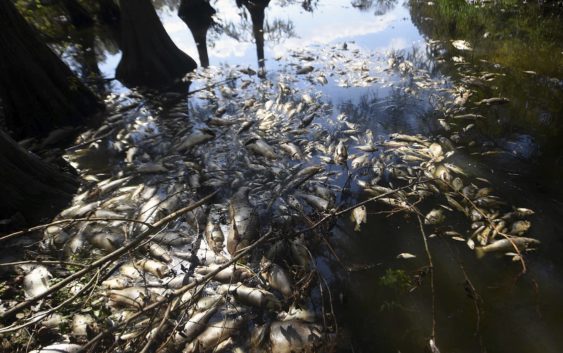- Austin leaders consider expanding wildfire protection plan
- Large hail, strong winds and tornado threat possible into Thursday evening
- Large hail, tornado threat possible Thursday evening
- Jaccob Slavin scores in OT as the Hurricanes beat the Capitals in Game 1 of their 2nd-round series
- 5 On Your Side: What happened to cars flooded during Hurricane Helene?
What caused fish kills after Hurricane Florence

Officials plan to survey, restock rivers
After Madi Polera investigated fish kills in the wake of Hurricane Florence, her car and clothes retained the overpowering stench of dead aquatic life for days.
“It just hangs out in your senses for days, and it’s death,” said Polera, Cape Fear River Watch’s assistant project manager. “So you really try to get out as quickly as you can, get the photos that we needed, get the data that we needed and move on.”
As Hurricane Florence’s floodwaters crawled their way down the region’s rivers, they contained little dissolved oxygen, which is necessary for fish’s survival. While the river below Lock and Dam No. 1 is supposed to contain dissolved oxygen levels of 5 parts per million (ppm), Polera’s team recorded levels of 0.2 to 0.3 ppm.
The N.C. Wildlife Resources Commission records fish kills in the state. Chad Thomas, the supervisor of the coastal region’s fisheries, said floodwaters picked up vegetation, debris and already stagnant water and dragged it into the river, resulting in fish kills.
“All that water that’s flushing from those swamps is the culprit for a crash in the amount of dissolved oxygen to the point that in most systems after Hurricane Florence it went to zero,” Thomas said. “It wasn’t just low, it was zero-point-zero.”
Low levels
According to the Wildlife Resources Commission, fish kills in the region took place on the Lower Cape Fear River, in Sutton Lake, on the Northeast Cape Fear River from Kenansville to Wilmington, and on the Black River between Garland and where it meets the Cape Fear.
Records from the N.C. Division of Water Resources show that after Florence an estimated 3,000 fish died in Greenfield Lake, 5,000 died at Lock and Dam No. 1 and 1,000 died at Lock and Dam No. 2 — the last two both on the Cape Fear River. Species impacted included American eels, blue catfish and largemouth bass.
Impacts become visible, Thomas said, when levels dip below 2 ppm.
“That’s where you start to see fish gasp, they become lethargic, they start to swim in circles. They’re struggling,” Thomas said. “And once it drops below one, that’s where death occurs.”
As of last week, levels on both the Cape Fear and Northeast Cape Fear rivers remained below 2 ppm. During 2016’s Hurricane Matthew, River Watch did not record water levels as low as they did during Hurricane Florence’s widespread flooding.
“(During Matthew) the floodwaters moved so fast that once it flushed the landscape, it flushed the river as well,” Polera said, “but Hurricane Florence’s flooding moved so slowly it wasn’t able to flush the river.”
While vegetative debris and other organic matter make up much of what is flushed into rivers — and are largely responsible for the water’s tea-like color — Nathan Hall, a research scientist with the University of North Carolina Institute of Marine Sciences, said human impacts can draw oxygen levels down as well. Substances like sewage, agricultural waste and fertilizer all wash into waterways along with other debris.
“A lot of that stuff that people are responsible for tends to be a lot more reactive than that natural stuff,” Hall said. “So you wash all that water into the river or estuary, and the bacteria consumes that organic matter and in the process it draws down oxygen levels, and that’s really all it takes.”
Recovery
The Wildlife Resources Commission will conduct electrofishing surveys up and down the N.C. coast in November to determine what species are left, with a follow up conducted next spring.
“If we go in the fall and find no fish,” Thomas said, “then there’s a chance when we go in the spring, we’ll find no fish, as well.”
River Watch, said Polera, is particularly concerned about the river’s species that were already dwindling. With the river’s sturgeon population estimated at under 100, there have already been reports of 10 dead as a result of Florence. The N.C. Spot Festival also has canceled this year’s event in Hampstead scheduled for Nov. 3-4, in part because of a lack of fish — something attributed to Florence.
One effort to restore populations will involve the annual striped bass stocking. This year, 100,000 striped bass — totaling 10 tons of fish — will be placed into the river the first week of December, with half going below Lock and Dam No. 1 and the other half below Lock and Dam No. 2.
The Watha State Fish Hatchery in Pender County, where the bass are grown, survived the storm without any impacts, said Thomas, in part due to the way the ponds and berms are set up.
“Those fish did fine, and they’re beautiful fish,” he said.
Other potential restockings could include bluegill sunfish, largemouth bass or catfish, Thomas added, with those fish being introduced to rivers in the fall of 2019. While the stocking will largely include young fish, the commission may also consider moving adult fish from some areas where there are large populations.
“We don’t get paid to hope,” Thomas said. “We get paid to try to make corrections as fast as we can, so stocking will definitely be a strategy.”
Reporter Adam Wagner can be reached at 910-343-2389 or Adam.Wagner@GateHouseMedia.com.